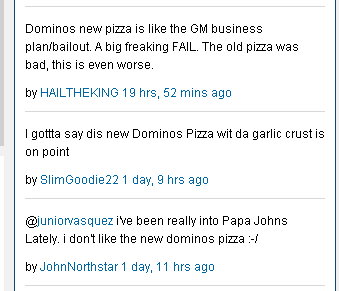Let’s say you make mass-produced pizza that tastes like cardboard. How would you sell it?
A) Hire Jessica Simpson as a spokesperson to tell everyone how good your pizza tastes
B) Have your founder drive across the country in a classic sports car to tell everyone how great your pizza tastes
C) Launch a nationwide campaign to tell everyone how bad your pizza tastes (and then make it better)
Domino’s Pizza actually picked option C (and if they didn’t, really, would it be worth blogging about?). In fact, the cardboard reference above is something Domino’s itself is promoting…
This campaign is a great example of two principles we teach about in our training workshops…
Transparent Marketing
So let’s get back to why I’m writing about a pizza campaign. It overcame one of the first hurdles in a crowded, overwhelming, thousands-of-sales-messages-per-day marketplace – it stood out. It grabbed my attention. And I even remembered the marketer’s name. How often can you say that about a pizza (or any other) marketing campaign?
As George Orwell has said, “In a time of universal deceit, telling the truth is a revolutionary act.” And, without being too harsh on my marketing peers, “universal deceit” is a pretty good summation of most marketing today. As Dr. Flint McGlaughlin has said, “When you say ‘sell,’ I hear ‘hype.’”
And that’s precisely why Transparent Marketing is so powerful. With the rise of social media, it is not hard for prospective customers to quickly learn the truth about your product. If you openly admit your weaknesses, you may be able to gain their trust. And, ultimately, every sale is an act of trust.
In Domino’s case, they are readily embracing social media – including every tweet, good or bad, right on their microsite:
Optimization Sequence
Of course, if your weaknesses are big enough, simply admitting them isn’t enough. You actually have to improve. Let’s take a quick look at the MarketingExperiments Optimization Sequence formula:
Opr > Oprn > Ocnn ©
Wherein:
Opr = Optimize Product Factor
Oprn = Optimize Presentation Factor
Ocnn = Optimize Channel Factor
As you can see in the formula, you must ensure you have an effective value proposition before you try to express it to prospects.
Of course, this can be the biggest challenge for marketers. First, admit your product has a problem. And then second, investing the resources and (in some cases) political capital to try to improve it.
In this case, social media can be your friend as well. Don’t just use services like Twitter as a one-way communication tool. Listen to what your customers are saying about you. Use this feedback, combined with other ways of communicating with (not to) your customers, to find ways to improve your product and build a case internally to invest in these improvements.
Grab the zeitgeist and don’t look back
If you look closely at how Domino’s Pizza applied these principles, they didn’t do it in a vacuum. The name of their campaign is The Pizza Turnaround.
The word Turnaround has been splashed all over the news in the past few years. With the biggest financial and automotive companies in the world needing government assistance to stay solvent, and then looking to make changes to return to profitability, the public has gotten quite used to companies needing to improve the way they do business.
So if you haven’t yet, now is a quite auspicious time to begin applying the principles of Transparent Marketing. Heck, even the notoriously broody band Pearl Jam has been writing about making a turnaround of sorts. As Eddie Vedder sings in the recent song “The Fixer”…
When something’s dark
Lemme shed a little light on it
When something’s cold
Lemme put a little fire on it
When something’s broke
I wanna put a little fixing on it





I wonder if they considered the case of the New Coke debacle from 1985? Are we going to see a consumer revolt in favor of their “classic” cardboard-flavored pizza crusts?
They had to do something because their pizza to me tasted awful. It tasted like cardbpard and they were getting destroyed by the competition. I think the marketing plan was great because they admitted that the pizza tasted bad and that they were devoted to changing it.